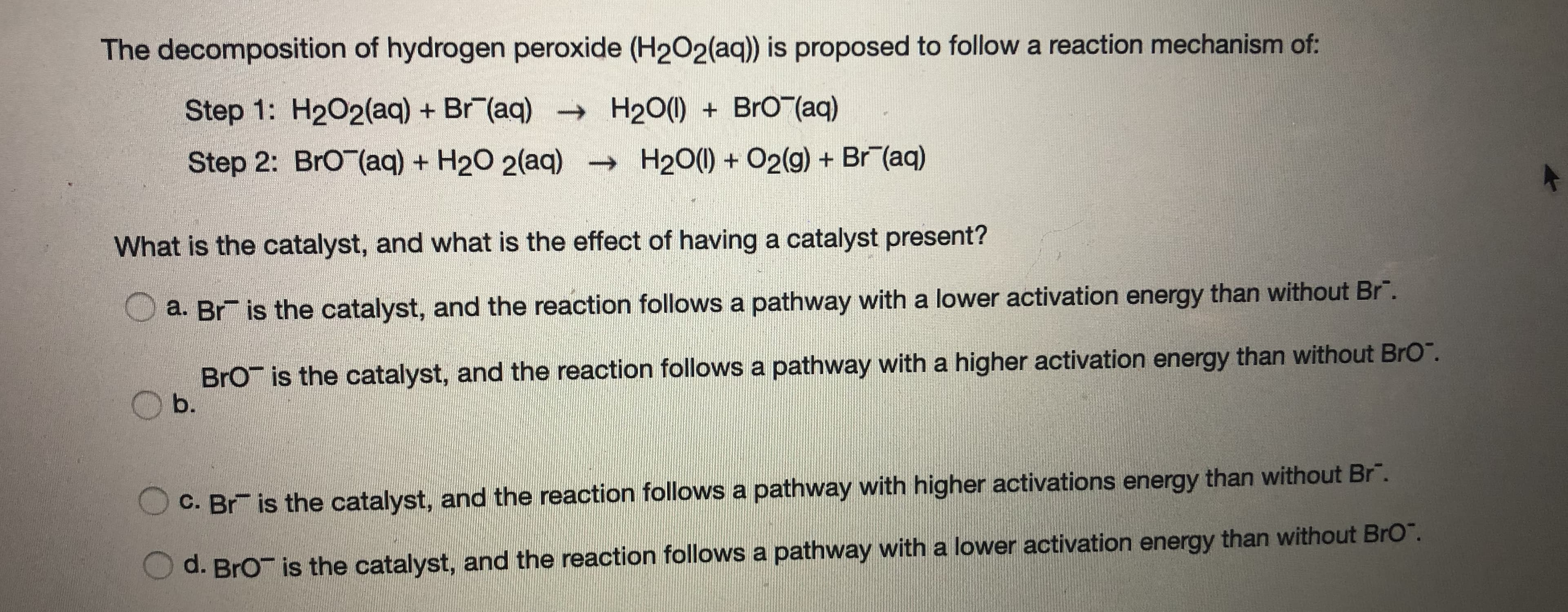The decomposition of hydrogen peroxide (H202(aq)) is proposed to follow a reaction mechanism of: Step 1: H202(aq) + Br (aq) - H20() + BrOT(aq) Step 2: BrO (aq) + H20 2(aq) - H20() + O2(g) + Br (aq) What is the catalyst, and what is the effect of having a catalyst present? O a. Br is the catalyst, and the reaction follows a pathway with a lower activation energy than without Br". BrO is the catalyst, and the reaction follows a pathway with a higher activation energy than without BrO". b. C. Br is the catalyst, and the reaction follows a pathway with higher activations energy than without Br". O d. BrO is the catalyst, and the reaction follows a pathway with a lower activation energy than without BrO".
The decomposition of hydrogen peroxide (H202(aq)) is proposed to follow a reaction mechanism of: Step 1: H202(aq) + Br (aq) - H20() + BrOT(aq) Step 2: BrO (aq) + H20 2(aq) - H20() + O2(g) + Br (aq) What is the catalyst, and what is the effect of having a catalyst present? O a. Br is the catalyst, and the reaction follows a pathway with a lower activation energy than without Br". BrO is the catalyst, and the reaction follows a pathway with a higher activation energy than without BrO". b. C. Br is the catalyst, and the reaction follows a pathway with higher activations energy than without Br". O d. BrO is the catalyst, and the reaction follows a pathway with a lower activation energy than without BrO".
Chemistry by OpenStax (2015-05-04)
1st Edition
ISBN:9781938168390
Author:Klaus Theopold, Richard H Langley, Paul Flowers, William R. Robinson, Mark Blaser
Publisher:Klaus Theopold, Richard H Langley, Paul Flowers, William R. Robinson, Mark Blaser
Chapter12: Kinetics
Section: Chapter Questions
Problem 65E: The hydrolysis of the sugar sucrose to the sugars glucose and fructose, C12H22O11+H2OC6H12O6+C6H12O6...
Related questions
Question

Transcribed Image Text:The decomposition of hydrogen peroxide (H202(aq)) is proposed to follow a reaction mechanism of:
Step 1: H202(aq) + Br (aq) - H20() + BrOT(aq)
Step 2: BrO (aq) + H20 2(aq)
- H20() + O2(g) + Br (aq)
What is the catalyst, and what is the effect of having a catalyst present?
O a. Br is the catalyst, and the reaction follows a pathway with a lower activation energy than without Br".
BrO is the catalyst, and the reaction follows a pathway with a higher activation energy than without BrO".
b.
C. Br is the catalyst, and the reaction follows a pathway with higher activations energy than without Br".
O d. BrO is the catalyst, and the reaction follows a pathway with a lower activation energy than without BrO".
Expert Solution
This question has been solved!
Explore an expertly crafted, step-by-step solution for a thorough understanding of key concepts.
This is a popular solution!
Trending now
This is a popular solution!
Step by step
Solved in 2 steps with 1 images

Knowledge Booster
Learn more about
Need a deep-dive on the concept behind this application? Look no further. Learn more about this topic, chemistry and related others by exploring similar questions and additional content below.Recommended textbooks for you

Chemistry by OpenStax (2015-05-04)
Chemistry
ISBN:
9781938168390
Author:
Klaus Theopold, Richard H Langley, Paul Flowers, William R. Robinson, Mark Blaser
Publisher:
OpenStax

Chemistry
Chemistry
ISBN:
9781305957404
Author:
Steven S. Zumdahl, Susan A. Zumdahl, Donald J. DeCoste
Publisher:
Cengage Learning


Chemistry by OpenStax (2015-05-04)
Chemistry
ISBN:
9781938168390
Author:
Klaus Theopold, Richard H Langley, Paul Flowers, William R. Robinson, Mark Blaser
Publisher:
OpenStax

Chemistry
Chemistry
ISBN:
9781305957404
Author:
Steven S. Zumdahl, Susan A. Zumdahl, Donald J. DeCoste
Publisher:
Cengage Learning


Chemistry: An Atoms First Approach
Chemistry
ISBN:
9781305079243
Author:
Steven S. Zumdahl, Susan A. Zumdahl
Publisher:
Cengage Learning

Chemistry for Engineering Students
Chemistry
ISBN:
9781337398909
Author:
Lawrence S. Brown, Tom Holme
Publisher:
Cengage Learning

Chemistry: Principles and Practice
Chemistry
ISBN:
9780534420123
Author:
Daniel L. Reger, Scott R. Goode, David W. Ball, Edward Mercer
Publisher:
Cengage Learning